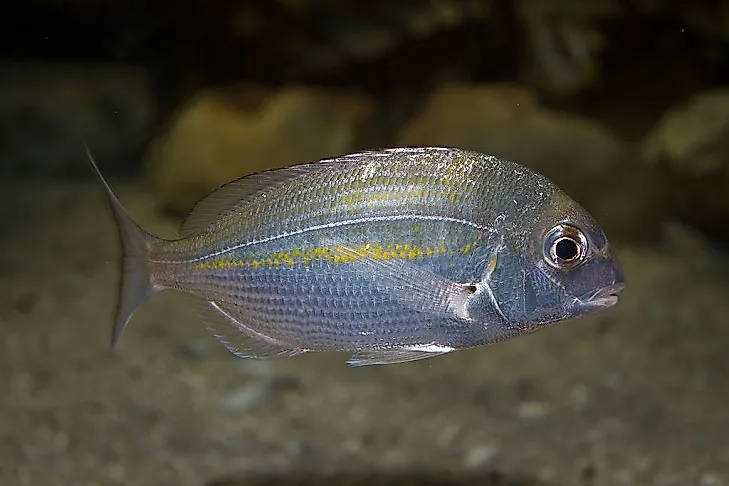Native Fish Of South Africa

South Africa's Indian, Southern, and Atlantic marine waters, along with its many rivers and lakes, are each home to various different species of fish. With 3,000 kilometers of coastlines, numerous dams, lakes, rivers, and streams, the country has an abundance of freshwater and marine life. 15% of all known coastal marine species are found on South Africa’s coast. Some of the country’s native fish species include the Plain Squeaker, Freetail Brotula, Cape Stumpnose, Phongolo Suckermouth, Cape Needlefish, Sixgill Hagfish, Southern Dwarf Minnow, White Barbel, Hyphen Barb, and Leaden Labeo.
Plain Squeaker (Synodontis Zambezensis)
The Plain Squeaker (Synodontis Zambezensis) is a species of upside-down catfish native to the Zambezi River system that spreads across Tanzania, Mozambique, Zambia, Zimbabwe, Swaziland, and South Africa. It resides in pools and slow-flowing reaches of perennial and seasonal rivers. It is more common in riverine habitats than floodplains, living in crevices or the underside of logs, usually in the upside-down position. It can reach a length of 43 centimeters, and its spines are reportedly poisonous. It is active at night, and feeds on detritus and plant matter, usually seeds or insects and snails. It is also a scavenger. The Plain Squeaker is oviparous, with distinctive pairing during breeding. It breeds in the summer time.
Freetail Brotula (Bidenichthys Capensis)
The Freetail Brotula (Bidenichthys Capensis) is an uncommon South African fish in the Bythitidae Family, and is one of three related species classified in the Genus Bidenichthys. It lives in the intertidal zones and rocky tide pools, ranging along the South East Atlantic around the Cape of Good Hope. It can be as long as 9 centimeters. It is found at a depths ranging from 11 meters to 30.5 meters, and at a temperature range between 19.831 Degrees Celsius and 20.525 Degrees Celsius.
Cape Stumpnose (Rhabdosargus Holubi)
The Cape Stumpnose (Rhabdosargus Holubi) is a fish species in the Sea Bream Family, and is native to South Africa, found living along the country's eastern coast. Its average length is 15 centimeters, with big ones reaching lengths of up to 40 centimeters. Its body is shiny silvery, with a gold line running from head to tail. Its dorsal fin has 11 spines. Its head is blunt, and its mouth has 6 to 8 incisors. The Cape Stumpnose is a marine fish, with adults living in the ocean, and juveniles in the estuaries in eelgrass beds where it is safe. The juveniles have cusped teeth that help collect aquatic plant matter. The juveniles feed mostly on eelgrass while adults have a diet of bivalves and crustaceans. The stock of Cape Stumpnose is declining, and the species is vulnerable to estuarine degradation.
Phongolo Suckermouth (Chiloglanis Emarginatus)
The Phongolo Suckermouth (Chiloglanis Emarginatus) is a species in the broad group known as the upside-down catfishes. It is native to Mozambique, Swaziland, Zimbabwe, and South Africa. It can grow to 6.5 centimeters in length. It lives in freshwater, mostly in Pongola, Komati, Pungwe, and the middle to lower Zambezi Rivers. It uses its mouth as a sucking disc to hold its position in fast flowing waters. Its mandibular teeth are for scraping invertebrates from stones. It resides in shallow rocky runs and riffles of clear rivers at an altitude of 900 meters to 1,200 meters above sea level, and depths ranging from 0.2 meters to 0.4 meters. It feeds on invertebrates such as mayfly nymphs. It is oviparous, with unique pairing during breeding. It breeds in the summer time. In South Africa, the Phongolo Suckermouth is threatened by the alteration of its habitat, which faces degradation from water extraction, regular flows from dams, and sedimentation resulting from agricultural and forestry activities.
Conservation of Fish Species in South Africa
Habitat improvements are required in order to help conserve these native fish species of South Africa. Improved farming and forestry practices should be encouraged to prevent habitat degradation. This can be achieved through conservancy agreements between riparian owners and conservation authorities. Another means of conserving fish species is to place controls on fishing methods and practices.
Native Fish Of South Africa
| Native Fish of South Africa | Scientific Binomial Name |
|---|---|
| Plain Squeaker | Synodontis zambezensis |
| Freetail Brotula | Bidenichthys capensis |
| Cape Stumpnose | Rhabdosargus holubi |
| Phongolo Suckermouth | Chiloglanis emarginatus |
| Cape Needlefish | Petalichthys capensis |
| Sixgill Hagfish | Eptatretus hexatrema |
| Southern Dwarf Minnow | Opsaridium peringueyi |
| White Barbel | Galeichthys feliceps |
| Hyphen Barb | Barbus bifrenatus |
| Leaden Labeo | Labeo molybdinus |











